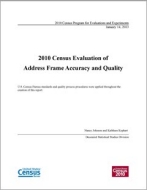2010 Census Evaluation of Address Frame Accuracy and Quality
2010 Census Evaluation of Address Frame Accuracy and Quality
Executive Summary
This report provides results from the 2010 Census Evaluation of Address Frame Accuracy and Quality. The Decennial Statistical Studies Division conducted this evaluation as part of the 2010 Census Program for Evaluations and Experiments to evaluate the accuracy of the address frame after the 2010 Census Address Canvassing operation and after completion of all 2010 Census operations. Specifically, this evaluation used results from the 2010 Census Coverage Measurement operation and a special supplemental field operation to estimate the number and percent of housing units correctly added (and added-in-error) and correctly deleted (and deleted-in-error) by census operations. In addition, this evaluation examine d the universe of addresses coded as “missing” from the census by the Census Coverage Measurement operation to determine if the census included them as valid housing units, but incorrectly geocoded them to a 2010 Census collection block outside of the Census Coverage Measurement geographic search area. This geocoding error analysis included a second supplemental field operation.
This evaluation was based on two Census 2000 studies:
- “Analysis of Deleted and Added Housing Units in Census 2000 Measured by the Accuracy and Coverage Evaluation” (Smith et al . , 2003), and
- “An Assessment of Addresses on the Master Address File ‘Missing’ in the Census or Geocoded to the Wrong Collection Block” (Ruhnke, 2003).
This evaluation expands on the work conducted by Smith et al. (2003) by including a component to estimate the number and percent of addresses that the 2010 Census Address Canvassing operation correctly added (and added-in-error) and correctly deleted ( and deleted-in-error) . The Smith et al. evaluation (2003) did not produce similar estimates for either Census 2000 Block Canvassing or Census 2000 Address Listing.
This evaluation addresses the following research questions:
How accurate was the address frame pre-Address Canvassing, post-Address Canvassing, and after final census operations? How can we improve address frame quality?
Since the accuracy and quality of the address frame is a broad topic that can include many components, this evaluation focused on changes and improvements to the census address inventory and narrowed the analysis to answer six operational study questions, as described in the following three paragraphs.
The “address frame” during the course of census operations is dynamic. The Pre-Address Canvassing address inventory, serving as the basis for the 2010 Census, is called the Master Address File. Measuring the accuracy and quality of this address frame was outside the scope of this evaluation due to timing, resources, and limitations in the difficulty of evaluating this universe. Our analysis provides documentation of the changes that were made to the address frame in the course of conducting the 2010 Census, which cannot be interpreted as a direct measure of accuracy of the address frame, but can give an indication of what updates were required to get the address frame “ready” for the 2010 Census.
While some of the records on the Master Address File represent valid living quarters, other records represent duplicate units, nonresidential addresses, nonexistent units, uninhabitable units, or other types of invalid records. A subset of the Master Address File records that were the most likely to be potential valid living quarters went into the Address Canvassing operation for Listers to validate or correct. In addition, the Listers added addresses missing from this list. In the post-Address Canvassing list, this evaluation measured the accuracy of actions taken during Address Canvassing and, specifically, answered operational study questions one and two below.
After Address Canvassing, a Group Quarters Validation operation made further changes and enhancements to the census address inventory. This inventory then served as the basis for the Universe Control and Management system. The Universe Control and Management system tracked the flow of data to and from the census enumeration operations. At the completion of all census operations, the final status of living quarters is reflected on the Census Unedited File. Using the Census Unedited File, this evaluation measured the accuracy of housing units by answering operational study questions three to six below.
The six operational study questions are as follows:
- By source/operation, what proportion of Address Canvassing “Adds” were correctly added and erroneously added, according to their Census Coverage Measurement status?
- By source/operation, what proportion of Address Canvassing deleted/duplicated units were correctly deleted and erroneously deleted, according to their Census Coverage Measurement status?
- By source/operation, what proportion of the post-Address Canvassing “Adds” were correctly added and erroneously added, according to their final Census Coverage Measurement status?
- By source/operation, what proportion of the post-Address Canvassing deleted/duplicated units were correctly deleted and erroneously deleted, according to their final Census Coverage Measurement status?
- What was the total estimated percentage of census addresses geocoded to the incorrect 2010 Census collection block?
- Did the geocoding error estimate vary by type of enumeration area or by census region?
Others in Series
Publication
Publication
Publication




